Discover the latest spoken-word audio statistics in our roundup. This data will help you get to grips with listener habits and demographics, so you can build an effective audio content strategy for 2022.
(Want to know why listening is so popular all of a sudden? Check out our article: Why audio content is booming)
We keep this article up to date with the latest research, facts, and numbers, covering:
- Digital audio statistics
- Audio hardware statistics
- Who listens to spoken-word audio?
- Why do people listen to spoken-word audio?
- How and where do people listen to spoken-word audio?
- News audio publishing statistics
- Podcast statistics
- Audio article statistics
- Audiobook statistics
- Radio statistics
Digital audio statistics
74% of listeners consume audio during their daily rituals⁴⁰
40% of listeners plan their day and activities around audio content⁴⁰
Digital audio listening experiences have a stronger impact on the brain than radio listening experiences: +25% emotional intensity, +28% detail memory, +25% global memory, and +23% engagement²¹
47% of Americans pay for an audio subscription³
The average US adult listens to digital audio for 1 hour 34 minutes a day²
Spoken-word audio accounts for 28% of digital listening⁴
73% of over-12s in the US (approximately 209 million people) listened to online audio in the past month (2022)²⁹:
- 87% of 12 to 34-year-olds
- 81% of 35 to 54-year-olds
- 52% of 55 and overs
67% of over-12s (approximately 192 million people) in the US listened to online audio in the last week²⁹
71% of over-12s in Australia listened to online audio in the last week, listening for an average 13 hours and 31 minutes³⁸
Listened to online audio in the past month (2021)²⁸:
- UK (16+), 75%
- Australia (15+), 73%
- Canada (18+), 71%
- South Africa (15+), 61%
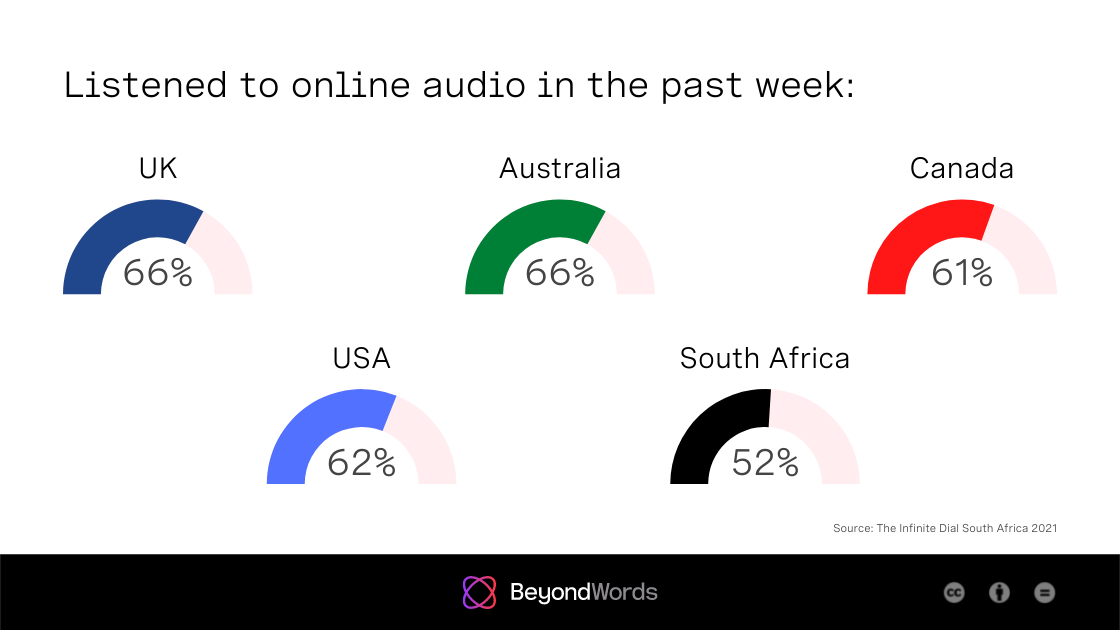
Listened to online audio in the past week (2021)²⁸:
- UK (16+), 66%
- Australia (15+), 66%
- Canada (18+), 61%
- South Africa (15+), 52% — listening for an average of 6 hours and 20 minutes
Audio hardware statistics
The number of smartphone subscriptions worldwide increased by 71% from 2017 to 2021, to 6.3 billion³⁵
Global annual headphone sales increased by 51% from 2016 to 2021, to 1.3 billion³⁶
35% of over-12s in the US own a smart speaker (2022)²⁹
Who listens to spoken-word audio?
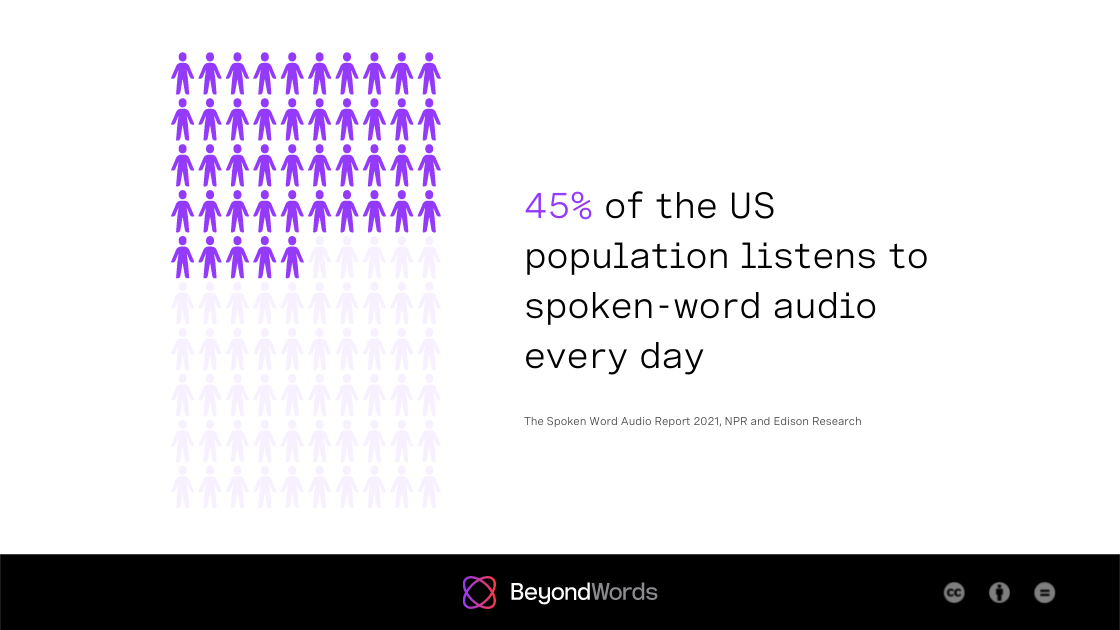
75% of the 18+ US population listens to spoken-word audio each month⁴
The average over-13 in the US listens to 1 hour and 4 minutes of spoken-word audio every day³⁹
46% of the 13+ US population listen to spoken-word audio daily:³⁹
- They listen to an average of 2 hours 19 minutes every day
- They spend more time with spoken-word audio than with music (51% vs 49%)
Share of US digital listening time spent listening to spoken-word audio (as opposed to music)
in 2022:³⁹
- Total: 29%
- On a mobile device: 34%
- By age: 13 to 34 (26%), 35 to 54 (30%), 55 and over (32%)
in 2021:⁴
- By gender: Men (32%), women (24%)
- By ethnic group: White/other (29%), African-American (22%), Hispanic/Latino (27%)
51% of US spoken-word audio listeners reported listening more in 2021 than they did five years previously⁴
Why do people listen to spoken-word audio?
Monthly listeners cite the following reasons for listening to spoken-word audio⁴
- the ability to multitask (71% — the most popular reason)
- it allows them to process information more efficiently (60%)
- they like listening more than reading (56%)
- they need to stay informed (52%)
Among this audience:
- 58% say spoken-word audio is a productive use of their time
- 54% say spoken-word audio engages their mind in a more positive way than other media
- 45% say spoken-word audio is becoming a more important part of their life
How and where do people listen to spoken-word audio?
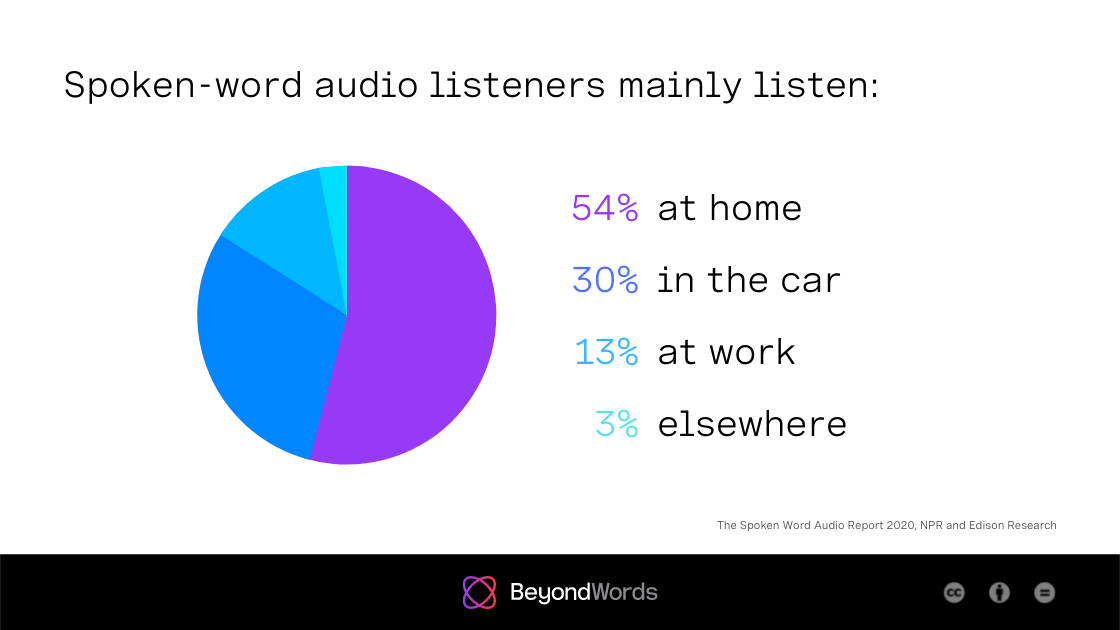
48% in the US listen via AM/FM radio, 22% via podcasts, 10% via audiobooks, 20% via other platforms⁴
47% in the US listen on an AM/FM radio receiver, 31% on a mobile device, 9% on a computer, 4% on a smart speaker, 9% on another device²⁴
54% in the US listen at home, 30% in the car, 13% at work, and 3% elsewhere²⁴
Searching the internet is the most common way for US listeners to discover new spoken-audio content, with 59% having done so⁴
49% of US spoken-word audio listeners listen exclusively alone, while 51% sometimes listen with others⁴
News audio publishing statistics
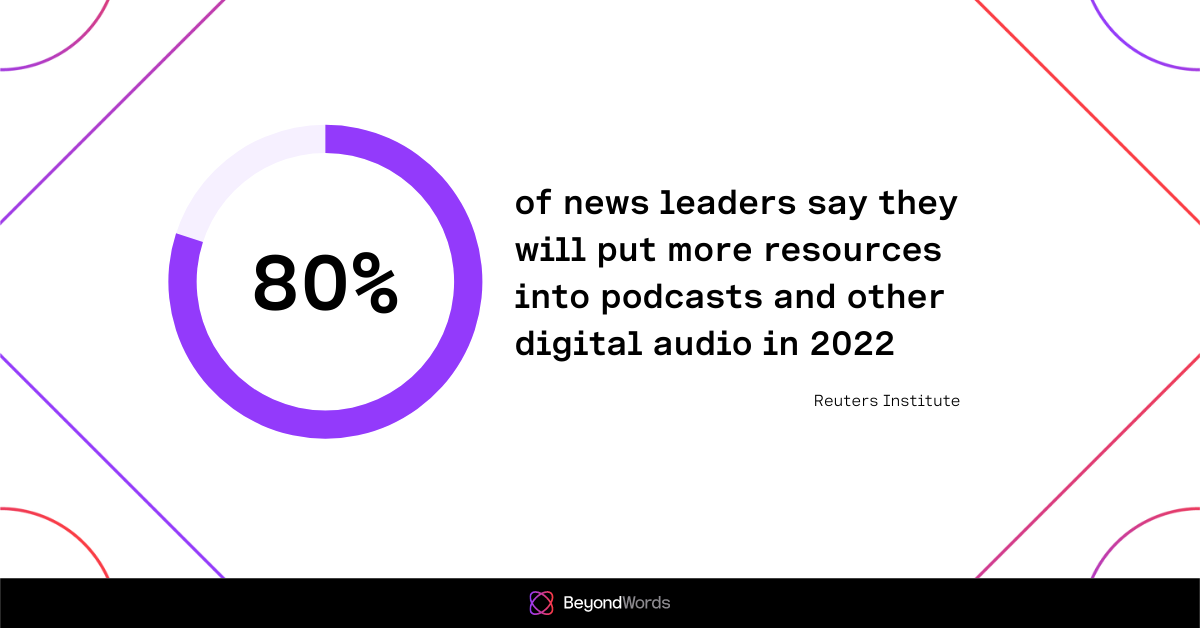
80% of news leaders will put more resource into podcasts and digital audio in 2022²⁷
The most popular spoken-word audio topic in the US is news/information, with 56% of listeners having consumed this type of content⁴
40% of spoken-word audio time in the US is spent listening to news or information³⁹
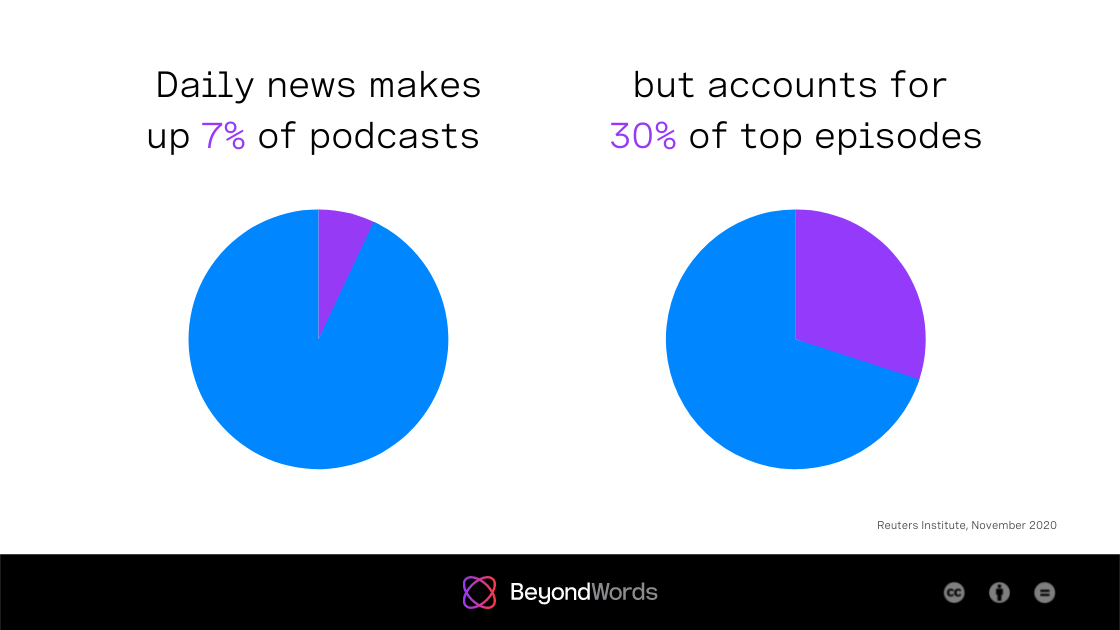
News podcasts make up 7% of all those produced but account for 30% of top podcast episodes in the US⁵
Daily news podcasts make up 1% of all those produced but account for 10% of top podcast episodes in the US⁵
43% of daily news podcasts take the format of a deep dive, 24% a news roundup, 20% a micro bulletin, 14% an extended chat (US, UK, Australia, Sweden, France, and Denmark)⁵
The Daily, a podcast published by The New York Times, averages four million downloads a day⁶
The Intelligence, a podcast published by The Economist, reaches around 2.5 million listeners per week.³³
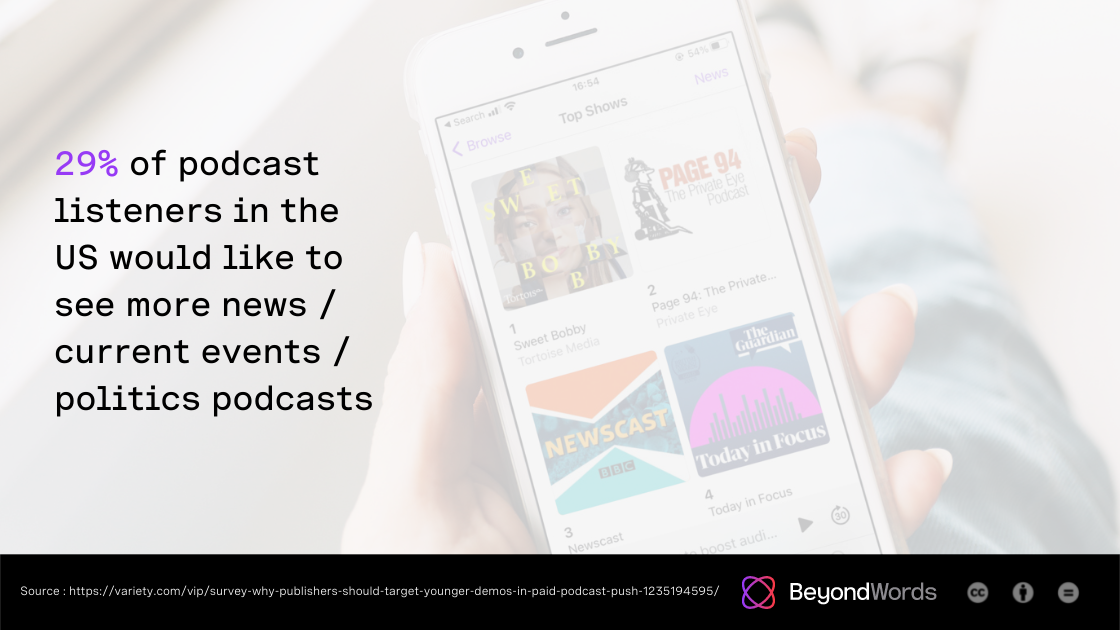
29% of podcast listeners in the US would like to see more news/current events/politics podcasts³²
Listened to a news podcast last week:³⁹
- Age 18 to 24: 13%
- Age 25+: 31%
News is the top genre for US podcast advertisers, accounting for 19% of revenue⁷
There were 51,406 news podcasts launched worldwide in 2020⁸
Podcast statistics
40% of millennials and Gen Zs rank their trust in podcasts higher than their average trust in traditional media sources⁹
25% of podcast listeners in the US and 14% in the UK said they are very or somewhat likely to pay money for a podcast in 2022³⁷
As of June 2022, there are over 67.4 million episodes on Apple Podcasts³⁴
Proportion who subscribe to audiobook or podcast services in the UK⁸:
- 18–24s (21%)
- 25–34s (18%)
- 35–44s (13%)
- 45–54s (12%)
- 55 and overs (5%)
Podcast awareness (2021)²⁸:
- Australia (15+), 92%
- Canada (18+), 78%
- USA (15+), 78%
- UK (16+), 71%
- South Africa (15+), 48%
How many people listen to podcasts?
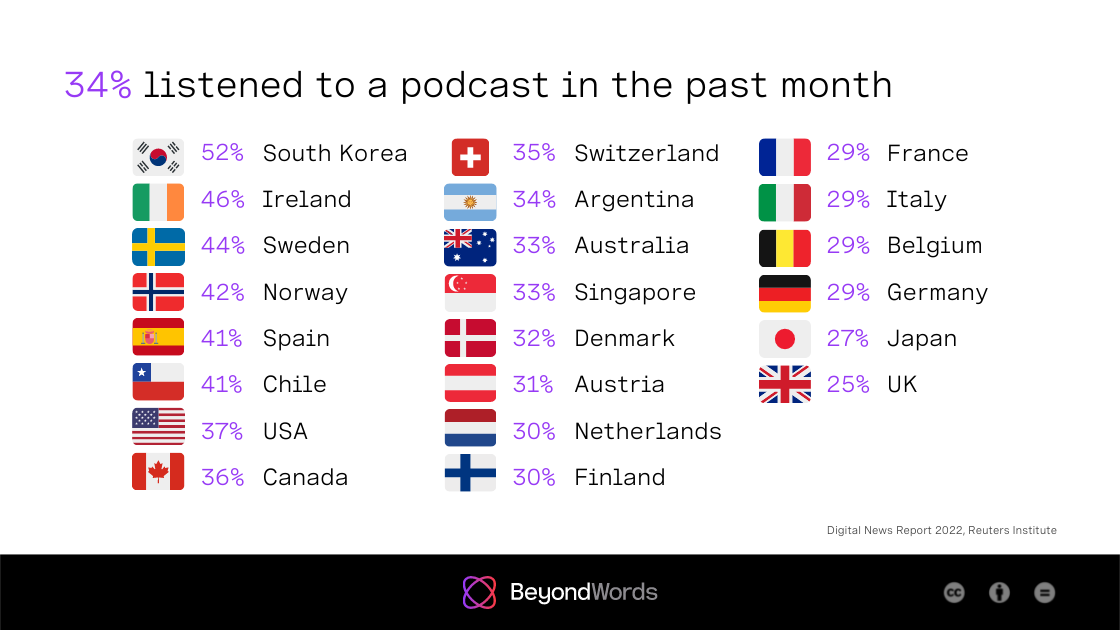
34% listened to a podcast in the last month (2022): South Korea (52%), Ireland (46%), Sweden (44%), Norway (42%), Spain (41%), Chile (41%), USA (37%), Canada (36%), Switzerland (35%), Argentina (34%), Australia (33%), Singapore (33%), Denmark (32%), Austria (31%), Netherlands (30%), Finand (30%), France (29%), Italy (29%), Belgium (29%), Germany (29%), Japan (27%), UK (25%)⁸
Listened to a podcast last week (2021)²⁸:
- USA (15+), 29%
- Australia (15+), 26%
- UK (16+), 25%
- Canada (18+), 23%
- South Africa (15+), 20% — listening to four episodes on average
29% of people across eight international markets listened to podcasts in the past week²²
95 million monthly active users in India (20% of the online population aged 12+) has listened to a podcast²⁵
280 million monthly active users in China (62% of the online population aged 12+) has listened to a podcast²⁵
53% of US podcast listeners listen weekly¹¹
62% of over-12s in the US have listened to a podcast²⁹
Who listens to podcasts?
US monthly podcast listeners²⁹:
- By gender: 53% men, 46% women, 1% other
- By age: 47% aged 12 to 34, 33% aged 35 to 54, 20% aged 55 and over
- By ethnic group: 59% white, 16% African-American, 16% Hispanic, 3% Asian, 6% other
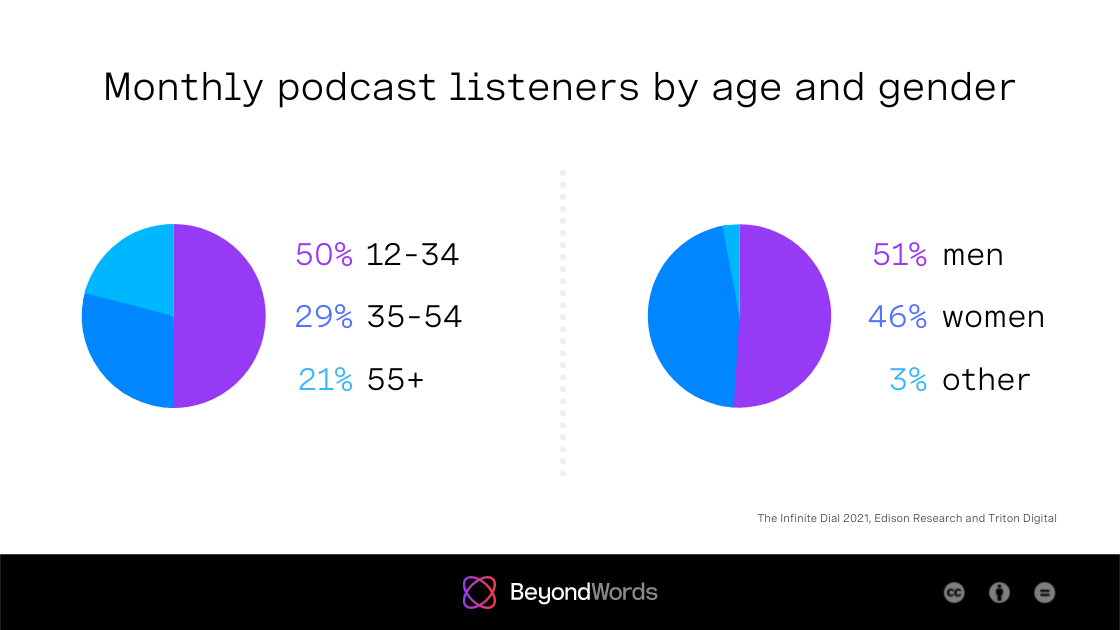
US monthly podcast listeners by generation: Gen Z (37%), Millennials (45%), Gen X (23%), Boomers (25%)¹⁹
UK weekly podcast listeners by generation: Gen Z (32%), Millennials (38%), Gen X (16%), Boomers (9%)²⁰
South African monthly podcast listeners²⁸:
- By age: 51% aged 15 to 34, 38% aged 35 to 54, 11% aged 55 and over
How and where do people listen to podcasts?
In the US, podcast listeners listen mainly through YouTube (26%), Apple Podcasts (22%), Spotify (17%), Google Podcasts (14%), Pandora (10%), NPR app or website (9%)¹⁰
In the UK, podcast listeners listen mainly through Spotify (30%), BBC Sounds (27%), Apple Podcasts (20%), YouTube (14%), Audible (8%), Google Podcasts (8%), or a news website/app (5%)⁸
In Germany, podcast listeners listen mainly through Spotify (25%), YouTube (19%), ARD Audiothek (12%), Apple Podcasts (11%), Audible (9%), Google Podcasts (8%), or a news website/app (8%)⁸
In Spain, podcast listeners listen mainly through YouTube (30%), Spotify (26%), iVoox (19%), Google Podcasts (13%), a news website/app (12%), Audible (7%), or Apple Podcasts (7%)⁸
In Australia, podcast listeners listen mainly through YouTube (26%), Spotify (25%), Apple Podcasts (23%), ABC app or website (22%), Google Podcasts (14%) Podcast Addict (8%)¹⁰
Main ways in which people discover new podcasts (USA/Europe)¹⁰:
- Recommendations from friends/family/work colleagues (37%/32%)
- Searching the internet (27%/39%)
- Recommendations or advertisements via social media (25%/27%)
- Recommendations via my usual podcast app (24%/20%)
- Recommendations or advertisements on other podcasts (21%/17%)
- Promotions for podcasts via radio or TV (17%/15%)
- Recommendations in newspapers/magazines (12%/14%)
Among US adults who have driven or ridden in a car in the last month, 30% have listened to podcasts in the car¹
Among weekly podcast listeners in the US (Q4 2021)²⁹:
- 20% most often listen in the car, 59% at home
- 13% most often listen on their desktop/laptop computer, 73% on a smartphone
Where monthly podcast listeners in South Africa (Major Metro Commercial Population, 15+) typically listen²⁸:
- 76% at home
- 13% at work
- 4% in a vehicle
- 7% other
Where monthly podcast listeners in Australia (12+) have listened³⁸:
- 83% at home
- 60% in a car/truck
- 50% while walking around/on foot
- 29% while riding public transportation
- 27% at work
- 19% at a gym/while working out
Podcast advertising statistics
US podcast advertising revenues exceeded $1.4 billion in 2021 and are expected to exceed $4 billion by 2024⁷
- Revenue has grown faster than the total internet ad revenue market (72% vs 35% year-on-year)
- Most ads (55%) are 16 to 30 seconds long
- Pre-roll, mid-roll, and post-roll ads account for 32%, 64%, and 4% of revenue respectively
In 2021, online audio generated $3.5–4 billion of revenue in China²⁵
Audio article statistics
69% of millennials and 61% of Gen Zs think audio formats are one of the greatest ways to tell stories⁹
62% of millennials and 52% of Gen Zs think audio amplifies more diverse perspectives than traditional media⁹
Zetland’s paying members consume 80% of articles via audio¹²
66% of people surveyed said there's too much visual stimulation in today's media landscape, and that audio provides a nice escape from it²¹
BeyondWords AI audio article statistics
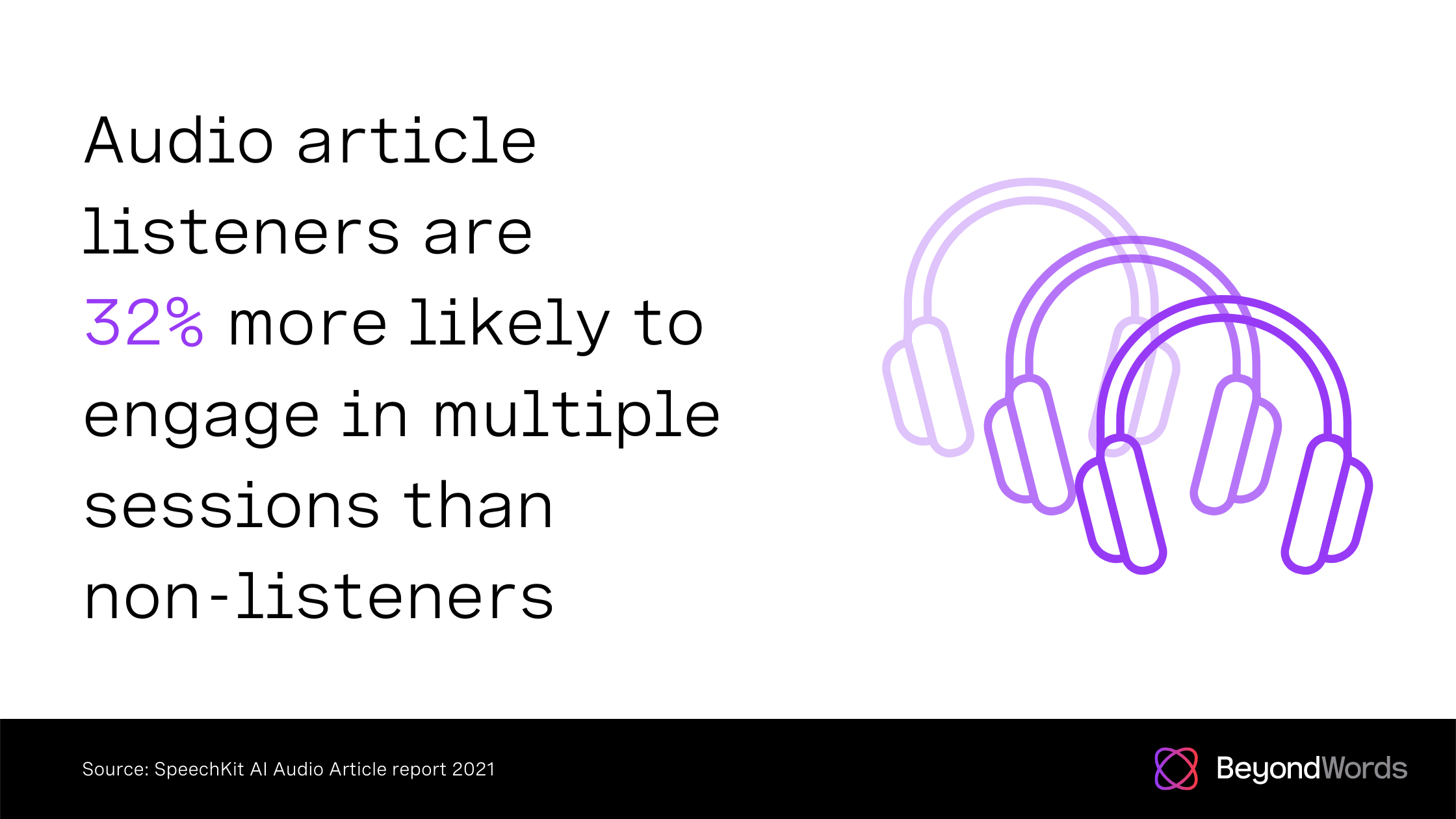
Non-listeners spend an average of 30 seconds on-site, whereas listeners stay for 322 seconds (+973%)¹³
Non-listeners visit 1.17 pages on average, whereas listeners visit 1.39 (+19%)¹³
Listeners are 32% more likely to engage in multiple sessions than non-listeners¹³
Returning visitors are 38% more likely to press play than new visitors¹³
The average new user who doesn’t engage with audio spends 2 seconds on-site, while the average new listener stays for 225 seconds (+11,150%)¹³
18 to 34s are 1.5x more likely to press play than 25 and overs¹³
35 to 54s who press play stay on-site for 9x longer than those who don’t¹³
55 and overs who press play visit 1.5x more pages than those who don’t¹³
Audiobook statistics
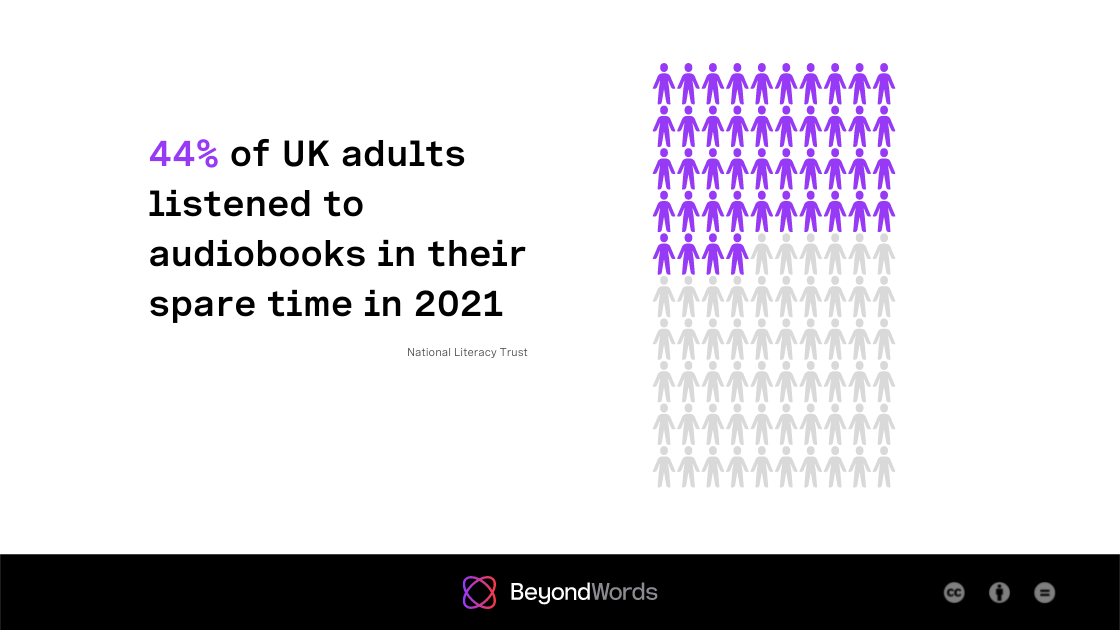
44% of UK adults said they listened to audiobooks in their spare time in 2021, with 27% listening at least once per week³⁰
- 72% said listening keeps their brain stimulated
- 70% said listening makes them feel less stressed and anxious
- 67% said listening cheers them up when they're feeling down
8% of adult British readers typically consume books into audiobook format¹⁴
- 6% (16 to 24), 13% (25 to 39), 7% (30 to 55), 6% (55 and over)
- 9% male, 7% female
In the UK, there were 24 million audiobook purchases in the 12 months to June 2021, accounting for a 6% share of the book market²⁶
54% of the US population (aged 12+) has listened to an audiobook²⁴, and 56% of listeners are under the age of 45¹⁵
US publishers' audiobook revenue grew 12% in 2020 to $1.3 billion¹⁵
55% of US listeners say they listen most of home, while 30% typically listen in the car¹⁵
38% of US audiobook listeners are subscribed to at least one audiobook service¹⁵
Business professionals cite listening to storytelling (26%) and accessibility/time-saving (26%) as the top benefits of audiobooks¹⁶
Most business professionals listen to audiobooks while driving (31%), doing housework/DIY (25%), exercising (18%) or walking (10%)¹⁶
Radio statistics
89% of the UK population listens into radio every week, with listeners tuning in for an average of 20.2 hours¹⁷
Speech radio stations reach 33% of UK adults every week²³
80% of the adult population in Ireland tunes into radio every day, listening for a total of 13.1 million hours³¹
88% of adults in the US listen to radio every week, with listeners tuning in for an average of 12.2 hours¹⁸
77% of people across eight international markets listened to radio in the past week²²
69% of South Africans (Major Metro Commercial Population, 15+), listened to radio in the last week²⁸
BeyondWords is an AI voice and audio CMS platform that brings frictionless audio publishing to writers, newsrooms, and businesses.

Have we missed anything? Email [email protected] to let us know.
Infographic
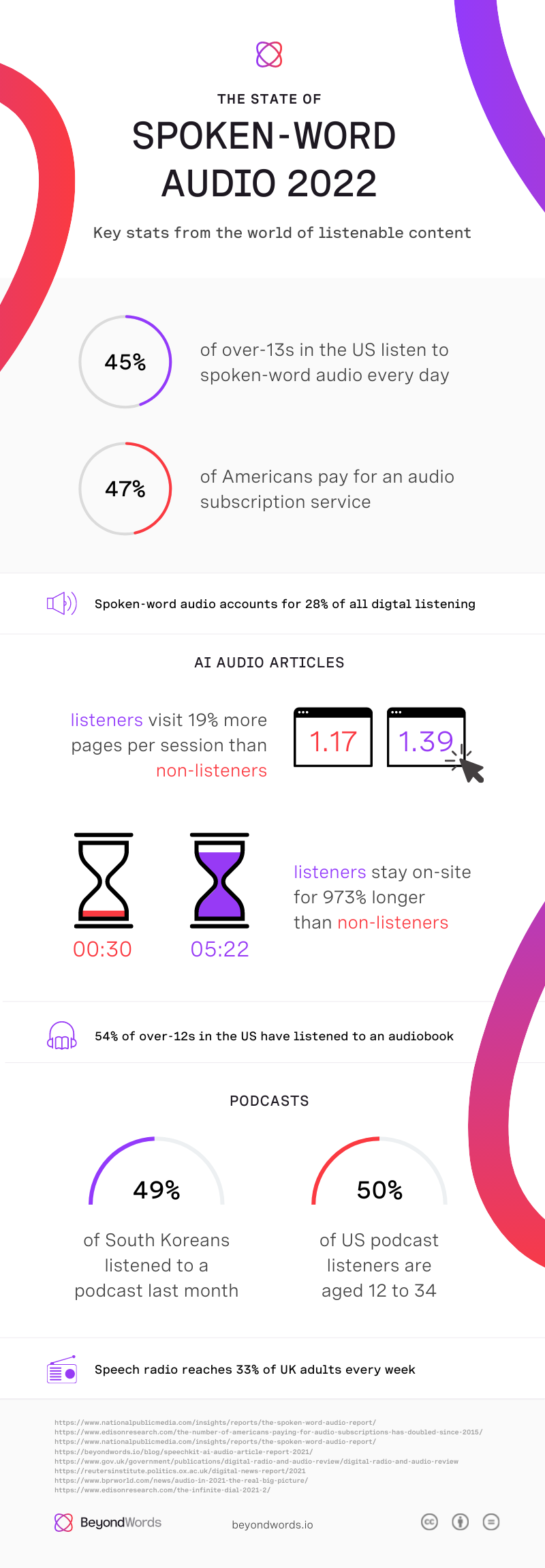
Sources
- The Infinite Dial 2021, Edison Research and Triton Digital, published March 2021
- The impressive resilience of digital audio, eMarketer, published February 2021
- the number of americans paying for audio subscriptions has doubled since 2015, Edison Research, published June 2021
- The Spoken Word Audio Report 2021, NPR and Edison Research, published November 2021
- Daily news podcasts: building new habits in the shadow of coronavirus, Reuters Institute, published November 2020
- What's next for America's favorite news podcast, CNN, published December 2020
- U.S. Podcast Advertising Revenue Study [PDF], Internet Advertising Bureau, published May 2022
- Digital News Report 2022, Reuters Institute, published June 2022
- How Millennials and Gen Zs Are Redefining Digital Audio, Spotify, published July 2021
- Digital News Report 2021, Reuters Institute, published June 2021
- Podcasting Today: Insights for Podcast Advertisers [PDF], Nielsen, published November 2020
- Audio articles help Zetland gain 2,000 new members during lockdown, Journalism.co.uk, published September 2020
- SpeechKit AI Audio Article Report 2021, BeyondWords (formerly SpeechKit), published July 2021
- What are common reading habits?, YouGov, published March 2020
- Audiobook Listening Remains Strong in 2020 as Publishers Report Ninth Straight Year of Double-Digit Growth [PDF], Audio Publishers Association, published June 2021
- Audiobook Statistics Reveals How Experts Use Audiobooks, Great Work Life, published April 2021
- Rajar Data Release: Quarter 1, 2020 [PDF], RAJAR, published May 2020
- Nielsen Total Audience Report 2021, Nielsen, published March 2021
- US Media consumption Report 2021, Attest, published September 2021
- UK Media consumption Report 2021, Attest, published June 2021
- Sonic Science: Understanding your brain on sound, Spotify, published September 2021
- Audio in 2021 – The Real Big Picture, BPR, published September 2021
- Digital radio and audio review, UK Government, published October 2021
- The Spoken Word Audio Report 2020, Edison Research, published October 2020
- India’s Podcast Market – World’s Fastest-Growing With Immense Potential, RedSeer, published December 2021
- Prime time for audiobooks, Nielsen BookData, published November 2021
- Journalism, media, and technology trends and predictions 2022, Reuters Institute, published January 2022
- The Infinite Dial South Africa 2022 [PDF], Broadcast Research Council of South Africa, published February 2022
- The Infinite Dial 2022, Edison Research, published March 2022
- Audiobooks: A survey of UK adults in 2021, National Literacy Trust, published March 2022
- Radio and the Irish Audio Market [PDF], JNLR, published August 2021
- Survey: Why publishers should target younger demos in paid podcast push, Variety Intelligence Platform, published March 2022
- The Economist's Podcasts Have Fetched Over a Billion Downloads Since Launch, AdWeek, published May 2022
- Apple Podcasts Statistics, Podcast Industry Insights, accessed June 2022
- How many smartphones are in the world?, BankMyCell, published June 2022
- Headphones, volume by segment, Statista, accessed June 2022
- UK and US: How many consumers are willing to pay for their podcasts?, YouGov, published April 2022
- Infinite Dial Australia 2022, Edison Research, published June 2022
- The Spoken Word Audio Report 2022, NPR and Edison Research, published October 2022
- 2022 State of Audio, Audacy, published October 2022